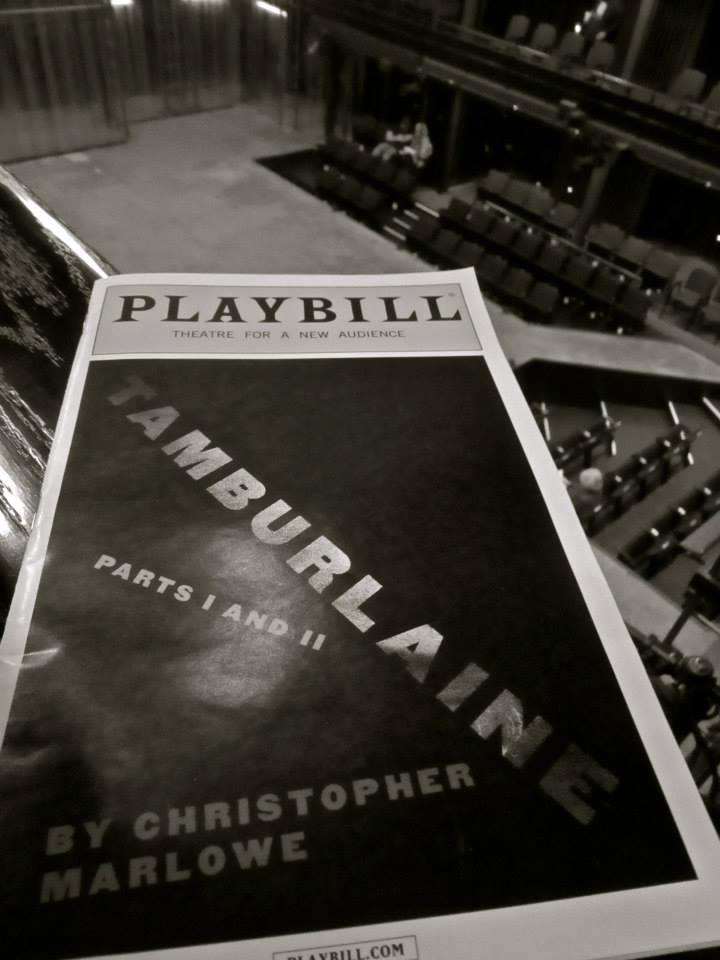It is, to begin with, astounding to be watching an actual production of Christopher Marlowe’s TAMBERLAINE THE GREAT on a professional stage. Marlowe is all too easily relegated to second place in the Elizabethan sweepstakes, and it is thrilling, for a change, to feel his theatrical pulse and the pure sensation of his storytelling. Michael Boyd’s production is both a footstep into the past and a kick to the shins of the present. Marlowe’s anti-hero anticipated, around 1590, the monstrous blood lust of the Jacobeans, as well as the tyrannical Macbeth and orientalist Othello of Shakespeare. Loosely inspired by the conquests of Timur, who briefly united the Islamic world, Mongul, Turkish, Indian, and Near Eastern, Marlowe made Tamburlaine the son of a Scythian shepherd, rather than of a minor noble as was the case. The result is intriguingly class-conscious: however bloody his exploits, there is a sense of humiliation and righteous rebellion at their root.
But he is, at the same time, no saint. Marlowe strips him of the religious sincerity the real Timur may have possessed; he is self-declared scourge of gods both pagan and Abrahamic, meeting death by divine retribution when he burns the sacred texts of Islam after his sack of the Ottomans. It is chilling, given the outrage such gestures can provoke, to see the blackened leaves (blank and uninscribed) flutter through the rafters of the Polonsky Shakespeare Center. One of the more notable things about TAMBURLAINE is, in fact, the respect it evinces for Islam; it is not only Tamburlaine who is struck down, but his Christian foes, when they turn duplicitously upon their Muslim allies. Marlowe was a notorious freethinker in his day, accused (as it would have been put then) of both atheism and homosexuality, so such departures from orthodoxy ought not to be so surprising as, confronted with them directly, they are.
Boyd’s staging, and the vigor of his actors, capitalize mercilessly on their theatrical value and take full advantage of the ferocious stage-worthiness of the dramaturgy. The verse is as blunt as it is blank, never stopping to eddy, as does Shakespeare’s, in pools of emotional depth and philosophical reflection, but flowing in rapids to the final cataract. Sensation piles on sensation, in a murderous advance portrayed, in Boyd’s vision, by pouring, brushing or dribbling a blood-red liquid on the costumes, persons, and properties of the drama, an effect at once graphic and abstract. Marlowe is adroit in offering opportunities for double casting; every death is a dragon’s tooth from which will spring a fresh persona for the actor just killed off. Twenty of them, in this production, play 44 parts, a stylistic choice that allows drama to mix with storytelling, enactment with visual narration. A spiritual continuity is created between successive roles, most strikingly between those of Merritt Janson, first as Tamburlaine’s kidnapped lover Zenocrate, and then, after her death, his military rival Callapine, who kisses him hard upon the lips as he descends into illness and death.
The imposing John Douglas Thompson is not double cast, but is claimed exclusively by Tamburlaine, starting the play with the diffidence of a shepherd and ending it in a fury of unrepentance. In between, he tastes in Marlowe’s words something like love, and later, when Zenocrate dies, its counterfeit, propping up her corpse like an idol and parading it behind him. That there will be another chance to see TAMBURLAINE staged, certainly anytime soon, and with such richness of sight, rhythm and sound, is doubtful; if it will matter at all to you to have missed it, there is until December 21 to forswear the possibility.
